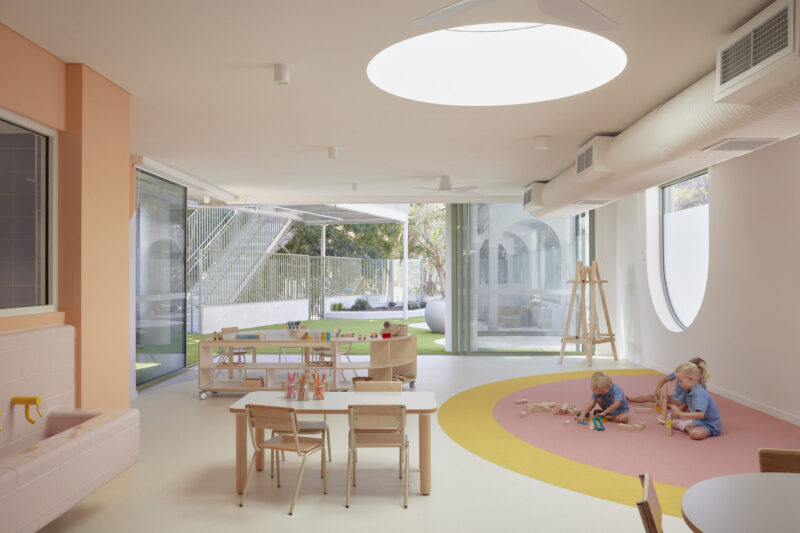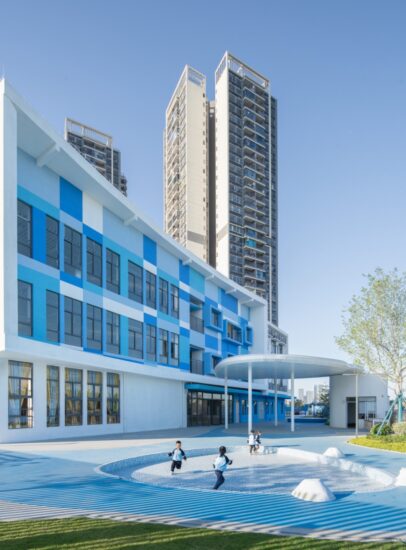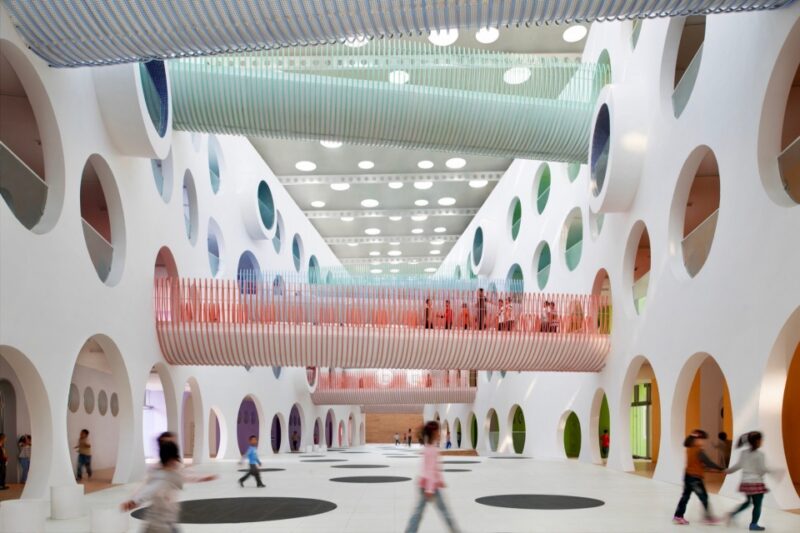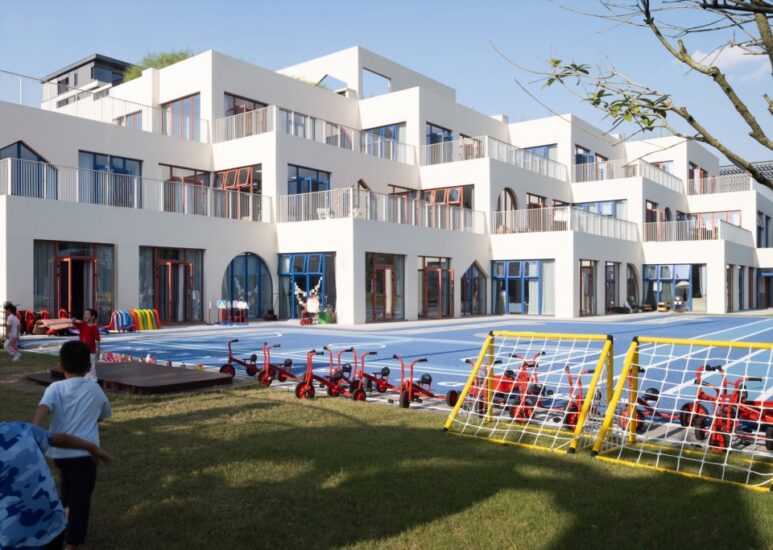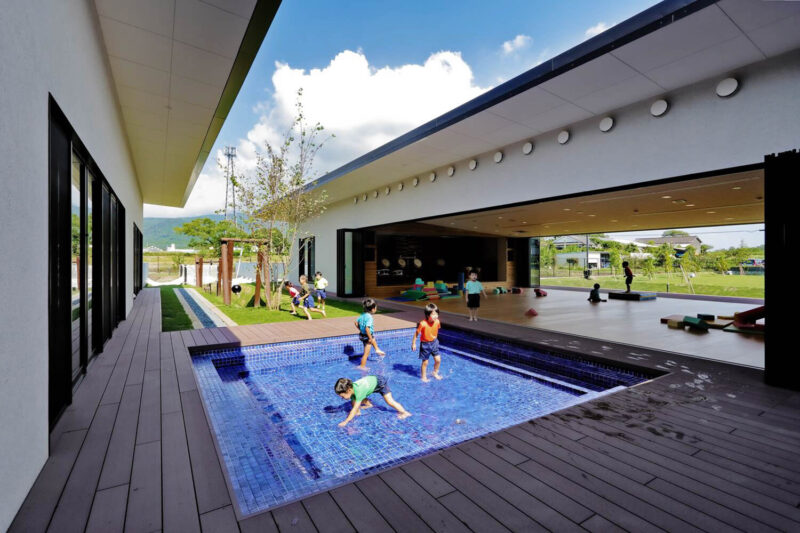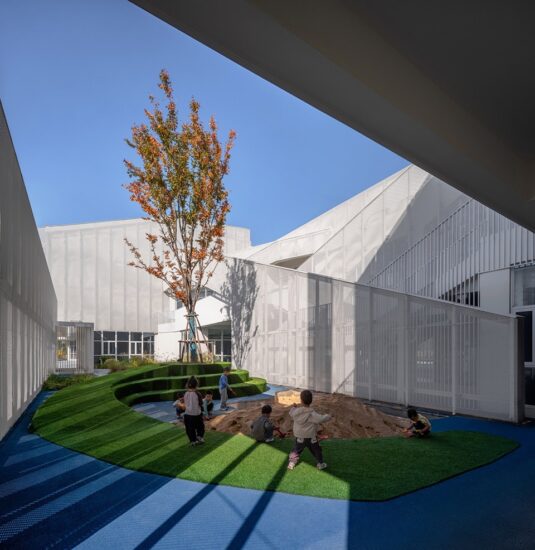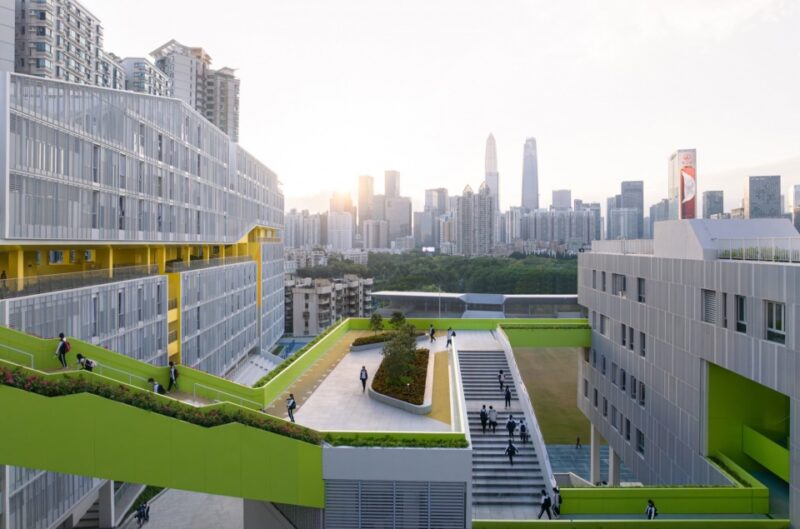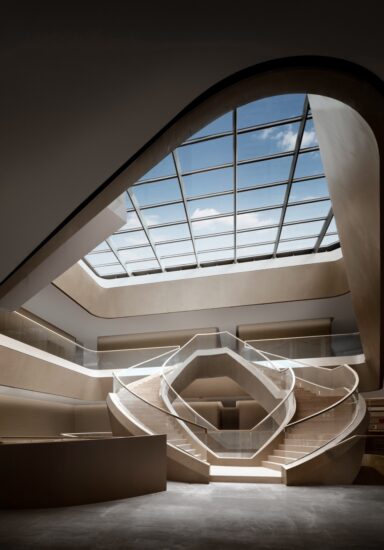北京大学协作式学习中心位于第二教学楼内,毗邻食堂与数学科学学院,如何将原有楼梯底下和旁边的边角位空间改造成融合北大元素,让学生都能有心理认同感的多元、交互、无界空间是本项目的重点。
The Collaborative Learning Center of Peking University is located in the Second Teaching Building, adjacent to the canteen and the School of Mathematical Sciences. How to transform the original corner space under and around the staircase into a diversified, interactive and borderless space that integrates typical elements of Peking University and gives the students a sense of psychological identity is the focus of this project.
北京大学是教育改革的先行者,我们希望在项目的改造设计中体现“守正和创新”的北大精神,并使之成为北大的人文景观新地标。这个空间是多元教育空间的试点,为自主式学习提供新场景。
Peking University has been a pioneer in education reform, and we hope to embody the University’s spirit of “Sticking to Convention and Encouraging Innovation” and to make it a new landmark of the University’s humanistic landscape. This space is a pilot of diversified education space, providing a new scene for autonomous learning.
∇ 项目区位 ©扉建筑 Site ©FEI Architects
∇ 第二教学楼首层平面图 ©扉建筑 First Floor Plan of the Second Teaching Building @FEI Architects
∇ 第二教学楼三层平面图 ©扉建筑 Third Floor Plan of the Second Teaching Building @FEI Architects
SITE 1:梯下空间再利用
SITE1: Reuse of Space under Staircase
北区学习中心位于第二教学楼的首层,选址于此主要是考虑到方便课间短时间的自修,同时靠近与社会外界联系最密切的东南门,在功能上可以作为一个交汇点,方便校内校外人士于此交流会面。但由于有个大楼梯的存在,导致原有空间低矮零碎,没有人气。
The Northern Learning Center is located on the first floor of the Second Teaching Building for the convenience of short-time self-study during break. Besides, it is near the southeast gate, which has the closest connection with the outside world. Functionally, it can serve as a joint point for people inside and outside the school to meet and communicate. However, due to the existence of a large staircase, the original space is low and fragmented, and thus lacks popularity.
为了引导人流,我们设计了一个朝向主入口大门的折形吊顶装置,并把原有低矮的楼梯底空间包了起来,木色材质也让人有了亲切感,将闲置空间变成了社交空间。大堂中间的柱子也被三面展板包了起来,成为了活动展演信息的传播墙。
In order to guide the pedestrian flow, we designed a folding ceiling device facing the main entrance, and wrapped up the bottom space of the original low staircase. The wood color material gives people a sense of intimacy, turning the idle space into a social space. The pillars in the middle of the lobby are also wrapped up by three exhibition boards, which have become bulletin board for activities information.
∇ 北区学习中心改造前平面 ©扉建筑 Plan of Northern Learning Center Before Renovation @FEI Architects
∇ 北区学习中心改造后平面 ©扉建筑 Plan of Northern Learning Center After Renovation @FEI Architects
∇ 北区学习中心改造前 ©扉建筑 Northern Learning Center Before Renovation @FEI Architects
∇ 北区学习中心改造后 ©扉建筑 Northern Learning Center After Renovation @FEI Architects
SITE 2:“树下”的学习空间
SITE2: Learning Space under the Tree
南区学习中心位于第二教学楼三层的最南侧,址于此主要是考虑到能汇聚三个方向的人流,且靠近校园主干道,方便往来教学楼建筑群和饭堂的学生人群抵达使用,但由于从立面到天花都是玻璃幕墙,夏天阳光直射,又闷又晒。于是我们在三个方向人流的汇聚处围绕其中一根柱子设计了一颗“大树”,“树下”可以成为学习交流的空间,同时树顶飘荡着的团团星云又起到遮阳防晒的作用。
The Southern Learning Center is located on the southernmost side of the third floor of the Second Teaching Building and the main reason for choosing this site is that it can gather people from three directions. Moreover, it is close to the main road of the campus, which is convenient for students commuting between the teaching building complex and the dining hall to arrive and use. But in summer, sunshine shoots in directly through the facade and ceiling made of glass curtain, making the place stuffy and sunny. Therefore, we designed a “big tree” around one of the pillars at the gathering point for people from three directions. Now “under the tree” can be a space for learning and communication, with the nebula floating above the treetop playing a role of solar screen.
∇ 人流动线分析 ©扉建筑 Analysis of Pedestrian Flow @FEI Architects
∇ 南区学习中心改造前平面 ©扉建筑 Southern Learning Center Before Renovation @FEI Architects
∇ 南区学习中心改造后平面 ©扉建筑 Southern Learning Center After Renovation @FEI Architects
∇ 利用现场的柱子作为“树”,设计“树下”学习空间 ©扉建筑
Using pillars on site as “trees” to design learning space “under the trees” @FEI Architects
∇ 南区学习中心 ©扉建筑 Southern Learning Center @FEI Architects
“树”旁边还有两个别致的“树屋”——“德先生”和“赛先生”,身处其中,黑色的主色调让人沉静,注意力集中;而半封闭的空间设计,既不会干扰他人,又不使人完全孤立。
There are two unique “treehouses” next to the “tree” – “Mr. Democracy and Mr. Science”, in which the main color of black makes people calm and concentrated; while the semi-enclosed space design makes sure people won’t interfere with others, but are not completely isolated either.
“人们聚集在村口的大树下,彼此交谈,相互协作,旁边还有两间小房子。这就是树下空间在自然界的映射,一种极强的归属感。”—— 米笑(扉建筑创始人)
People gather under a big tree at the entrance of the village, talking and cooperating with each other, with two small houses nearby. This reflects the space under trees in nature and a strong sense of belonging.
—— Michelle Yip(Founder of FEI Architects)
∇ “树”旁的“赛先生”树屋 ©扉建筑 “Mr. Science” Treehouse beside the “Tree” @FEI Architects
∇ 在“树屋”中学习 ©扉建筑 Learning in the “Treehouse” @FEI Architects
多元交互的可能
The Possibility of Diversified Interaction
设计师在空间设计中充分考虑了各种各样不同的功能需求。中央的自由式舞台采用流线型的设计,让空间多了灵动感。台子不高,既可在平时随意就坐,也可在有分享活动时用作舞台。同时为了尽可能呈现空间的多样性和层次感,在每个区域都布置有屏幕可供讨论分享。
A variety of functional requirements have been fully considered in the space design. The freestyle stage in the center adopts streamline design, which makes the space more flexible. The platform is not high, which can be used as a stage when there are sharing activities as well as for sitting freely at other times. At the same time, in order to present the diversity and multi-level vision of the space as much as possible, there are projection screens in each area for discussion and sharing.
∇ 流线型的中央舞台 ©扉建筑 Streamlined Center Stage @FEI Architects
∇ 随处可见的屏幕 ©扉建筑 Screen Everywhere @FEI Architects
学习空间改造前有一处两层通高的口袋空间,由于过于空旷而令人无法安定。这个空间旁边正好是楼梯,于是我们决定拆除栏杆,把台阶延伸至这个通高空间形成阶梯式的多功能座席。不仅大大增加了学习空间的座位数,也让空间尺度更加宜人。
Before the renovation, there was a two-storey pocket space, which was too empty to make people stay long. Next to this space is the staircase, so we decided to remove the railings and extend the steps to this high space to form a multi-functional stepped stand. It not only greatly increases the number of seats in the learning space, but also makes the space scale more pleasant.
黑红相间的“梯田”与书柜墙搭配,台阶的错落让空间更加立体,为讨论式的学习提供一种新的可能性。有演讲演出的时候,这些稍微远离舞台的座席往往更受欢迎,它可以在参与与自修之间自由切换。
The black and red “terraces” are matched with the bookcase wall, and the scattered steps make the space more three-dimensional, providing a new possibility for discussion-based learning. When there is a speech or performance, these seats relatively away from the stage are often more popular for they can be freely switched between participation and self-study.
∇ 改造前的两层通高空间 ©扉建筑 Two-storey High Space Before Renovation @FEI Architects
∇ 改造后成为黑红相间的“梯田”空间 ©扉建筑 Black and Red Terrace Space After Renovation @FEI Architects
艺术与设计的融合
Integration of Art and Design
我们在改造的过程中利用PVC管设计了一件名为“智慧”的艺术装置,既是遮阳的措施,又是晚上照明的灯具,还是一件原创艺术品。艺术与设计的融合,营造了美与无界的体验。
In the process of renovation, we used PVC pipe to design an art installation named “Wisdom”. Besides being shading device and lamp for lighting in the evening, it is also an original work of art. The integration of art and design creates an experience of beauty and borderless.
∇ 原创艺术品:“智慧”灯 ©扉建筑 Original Artwork: “Wisdom” Lamp @FEI Architects
∇ 艺术与设计的融合 ©扉建筑 Integration of Art and Design @FEI Architects
参与式设计
Participatory Design
通过组织“北大红”艺术工作坊,在工作坊中被师生们选出来的心中的“北大红”被运用于设计当中。主题墙和书屋黑板的设计绘制也都由师生共同完成。“参与式设计”的方式让师生们从一开始就参与项目形象的构建,传达出了和而不同的理念,体现了北大的自由精神与多元文化。
Through the “PKU Red” art workshop, the kind of red representing the University in the hearts of the teachers and students was selected and used in the design. The design drawing of the theme wall and the blackboard of the bookstore are also completed by teachers and students. The approach of “participatory design” enables teachers and students to participate in the construction of project image from the beginning, conveying the concept of “harmony with diversity”, and embodying the spirit of freedom and multiculturalism of Peking University.
∇ 被师生选出来的“北大红”运用于设计当中 ©扉建筑
“PKU Red” Selected by Teachers & Students and Used in the Design @FEI Architects
∇ 随处可见的“北大红” ©扉建筑 “PKU Red” Seen Everywhere @FEI Architects
∇ 由师生共同绘制的黑板墙 ©扉建筑 Blackboard Wall Drawn by Teachers and Students @FEI Architects
项目信息
项目名称:北京大学协作式学习中心
项目地点:北京大学
面积:423平方米
主创建筑师:米笑
设计团队:黄毅、卓锦万
业主:北京大学
Project Name:Collaborative Learning Center of Peking University
Location: Peking University
Building Area:423 m²
Chief Architect: Michelle Yip
Project Team: Erin Huang、Zhuo Jinwan
Clients:Peking University


























